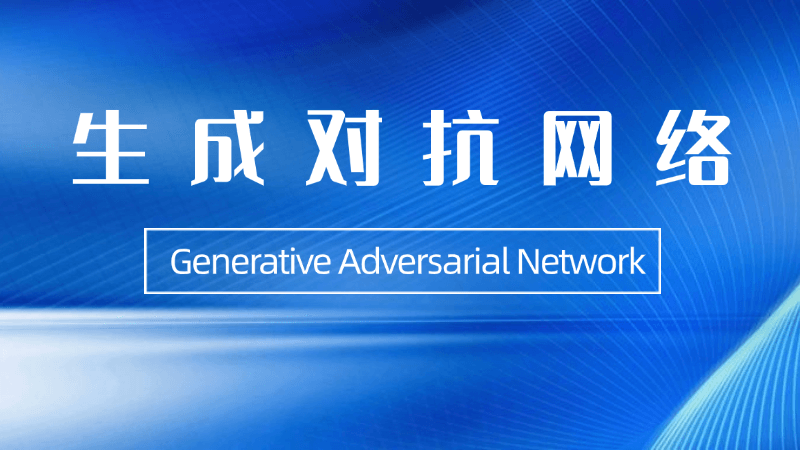What is Generative Adversarial Network (GAN) in one article?
Definition of Generative Adversarial Networks
Generative Adversarial Network (GAN) is a deep learning model proposed by Ian Goodfellow et al. in 2014. This framework implements the learning of generative models through the adversarial training of two neural networks: one, called Generator, is responsible for generating synthetic data from random noise; the other, called Discriminator, is responsible for distinguishing between generated data and real data. The Generator's goal is to generate data that is realistic enough to deceive the Discriminator, which seeks to accurately recognize the truth. This adversarial process motivates the two networks to continuously improve so that the generator can output high-quality data.The core idea of GAN stems from the zero-sum game in game theory, where two networks minimize their own losses while maximizing each other's losses. This architecture does not require explicit probability density estimation and learns the data distribution directly through adversarial training.GAN has demonstrated powerful capabilities in the areas of image generation, style transformation, and data augmentation, making it an important breakthrough in generative modeling.The innovative design of GAN opens up new avenues for generating content for AI and promotes the development of creative applications.

Historical origins of generating adversarial networks
- Background: In 2014, Ian Goodfellow proposed the concept of GAN while working on his PhD at the University of Montreal, inspired by game theory. At that time, generative models mainly relied on variational self-encoders or Boltzmann machines, but these methods suffered from low generation quality or training complexity.
- Early development: The original GAN was used to generate simple images such as MNIST handwritten numbers. The generators and discriminators used multilayer perceptron machines, and the infrastructure, though simple, proved effective against training.
- technological evolution: After 2015, researchers combined convolutional neural networks to introduce DCGAN (Deep Convolutional Generative Adversarial Network), which significantly improved the quality of image generation.DCGAN introduced convolutional layers, batch normalization, and architecture-specific rules, which served as the basis for subsequent research.
- Application extensions: In 2016-2018, GAN was extended to super-resolution, image restoration, and style migration. variants such as CycleGAN and StyleGAN emerged to support unpaired data training and fine-grained control generation.
- Current impact: GAN has become a core technology for generating models that advance fields such as art creation, medical imaging, and autonomous driving. Hundreds of related papers are published every year, continuously optimizing stability and generative diversity.
Generating core components of adversarial networks
- generator network: The generator receives random noise vectors as input and transforms them into target data distributions through a multilayer neural network. The network typically contains upsampling or transposed convolutional layers that progressively expand the spatial dimensions and refine the output. The generator's loss function drives it to produce more realistic data to trick the discriminator.
- discriminator network: The discriminator acts as a binary classifier, inputting real or generated data and outputting the probability that it is real. The network structure often uses convolutional neural networks to extract multi-level features for judgment. The optimization goal of the discriminator is to accurately distinguish between true and false, and provide an improved signal for the generator.
- adversarial loss function: GAN is optimized using Minimax loss. The generator tries to minimize the correctness of the discriminator and the discriminator tries to maximize its own performance. This dynamic equilibrium is achieved by alternating training, pushing both sides to improve together.
- Noise Input Design: The input to the generator is usually a Gaussian or uniformly distributed random vector. Noise dimensionality affects generative diversity; higher dimensionality may produce more diverse outputs, but will make training more difficult.
- network architecture variant: The base GAN uses fully connected layers, but modern variants use convolution, attention mechanisms, or Transformer components. For example, StyleGAN controls the generation of attributes through style vectors for fine tuning.
How Generative Adversarial Networks Work
- Training initialization: The generator and discriminator start with random weights. The generator produces low-quality outputs and the discriminator starts with a performance close to a random guess.
- counter-training cycle: Each round of training is divided into two steps: first, the discriminator is updated to compute the loss using both real and generated data; then the generator is updated to fix the discriminator weights and optimize the generative power through backpropagation.
- gradient update process: The discriminator loss uses binary cross-entropy with a true label of 1 and a generated label of 0. The generator loss, on the other hand, is based on the discriminator's judgment of the generated data, and the goal is for the discriminator to output a value close to 1.
- convergence sign (math.): Ideally, when the generated data distribution overlaps with the true distribution, the discriminator is unable to distinguish between truth and falsehood, and the output probability stabilizes at 0.5. At this point, the system reaches a Nash equilibrium, and the generator outputs high-quality samples.
- Training cessation conditions: In practice, the quality of generation is assessed by validation sets, or loss function changes are monitored. Stopping early prevents overfitting and ensures model generalization capabilities.
Application areas for generating adversarial networks
- Image generation and editing: GAN generates photorealistic images of faces, landscapes or objects for art creation and design. Editing applications include attribute modification (e.g. age, expression) and background replacement, and tools such as Photoshop integrate GAN functionality.
- Video and animation production: In the film and television industry, GAN enables video super-resolution, frame prediction and stylization. In animation production, it generates intermediate frames or transforms the drawing style to reduce manual workload.
- Medical Image Processing: GAN enhances medical image resolution and synthesizes training data to address sample shortage. In tumor detection or organ segmentation, generating data helps to improve diagnostic model accuracy.
- Data Enhancement and Privacy Protection: Generate synthetic data for machine learning models to scale up the training set. In privacy-sensitive domains, GAN creates anonymized data that retains statistical properties without revealing real information.
- Scientific simulation and innovation: The fields of physics and chemistry use GAN to simulate molecular structures or celestial phenomena. In materials science, generating novel material designs to accelerate the R&D process.
Outstanding Advantages of Generating Adversarial Networks
- Generating Quality Excellence: Images, audio, or text produced by GANs often achieve a high degree of fidelity, to the point where humans have difficulty distinguishing authenticity. This capability supports high-quality content creation and enhances the user experience.
- No explicit modeling required: In contrast to other generative models, GAN does not rely on complex probabilistic assumptions and learns data distributions directly through adversarial learning. This flexibility adapts to a wide range of data types and tasks.
- Creativity and diversity: GANs not only replicate existing data but also combine features to generate novel content. The art field utilizes this feature to create unique paintings or musical compositions.
- End-to-end training: The entire framework is optimized by gradient descent, eliminating the need to manually design features or process them in stages. All-in-one training simplifies the process and improves efficiency.
- Cross-cutting adaptability: The GAN framework is scalable to almost any data type, from images to text, 3D models and even time series. This versatility promotes multidisciplinary applications.
Challenging Limitations of Generating Adversarial Networks
- Training instability: The balance between the generator and the discriminator is difficult to maintain, with one side often dominating and the other stagnating. Loss function oscillations or divergence lead to training failures and require careful parameter tuning.
- Evaluating Difficulty: Lack of objective indicators to measure the quality of generation, IS (Inception Score) or FID (Fréchet Inception Distance) are commonly used but still controversial. Human assessment is costly and subjective.
- Computing resource requirements: Training high-quality GANs requires a lot of GPU time and memory, especially for HD image generation. Resource constraints prevent individual researchers or small organizations from participating.
- Ethics and Risk of Misuse: Generating realistic images can be used to falsify identities and disseminate false information. Deep forgery techniques are a cause for social concern and need to be standardized in their use.
Training Techniques for Generating Adversarial Networks
- Architecture Design Principles: Use convolutional layers instead of fully connected layers to improve spatial feature extraction. Add batch normalization to stabilize training to avoid gradient vanishing or explosion.
- Loss function improvement: the original minimization maximization loss is prone to saturation, and the Wasserstein distance or least squares loss is used instead. wgan-gp enhances training stability by gradient penalty.
- regularization method: Add noise to the discriminator input or use weight cropping to prevent overconfidence. Label smoothing techniques set the true label to 0.9 instead of 1 to reduce overfitting.
- Learning rate movement: Dynamically adjusting the learning rate of the generator and discriminator, commonly used with the Adam optimizer. Alternate training frequency balance, such as updating the generator once after updating the discriminator several times.
- Monitoring and Commissioning: Visualize generated samples to track progress and check for oscillating loss curves. Use validation sets to stop early and avoid invalid training.
Generating major variants of adversarial networks
- Conditional GAN: Labeling information is introduced to control the generated content, e.g., to specify the generation of a specific category of images. Conditional information is injected into the generator and discriminator through the embedding layer to realize directed generation.
- CycleGAN: Support for unpaired data field conversions, such as turning a horse into a zebra or a photo into an oil painting. Cyclic consistency loss ensures that the content remains consistent before and after conversion.
- StyleGAN: Fine control of generative attributes such as face age, hairstyle or lighting through style vectors. Layered style injection enables multi-scale editing to generate ultra-high resolution images.
- Wasserstein GAN: Use Wasserstein distance instead of raw loss to address training instability and pattern crashes. Gradient penalized version (WGAN-GP) further improves performance.
- Against Self-Encoders: Combines a self-encoder with a GAN to encode inputs as latent vectors before decoding them for generation. This structure improves latent space continuity and supports semantic interpolation.
Future Directions for Generating Adversarial Networks
- Training Stability Improvement: Investigate new loss functions or optimization algorithms to reduce hyperparameter sensitivity. Meta-learning or automated methods may simplify the tuning process.
- Controlled generation enhancement: Develop finer-grained control mechanisms that allow users to specify content, style, and layout. Text-to-image generation seeks greater consistency and variety.
- Cross-modal applications: Integrate text, images and audio for multimodal generation. For example, generating video based on descriptions, or converting music into visual art.
- Efficiency Optimization: Compressing the model size speeds up the reasoning process and adapts it to mobile devices or real-time applications. Knowledge distillation or quantization techniques reduce computational requirements.
- Ethics and Governance: Establish tools to detect generated content and prevent malicious use. Setting industry standards ensures responsible development of technology and promotes creative applications.
© Copyright notes
Article copyright AI Sharing Circle All, please do not reproduce without permission.
Related posts

No comments...




